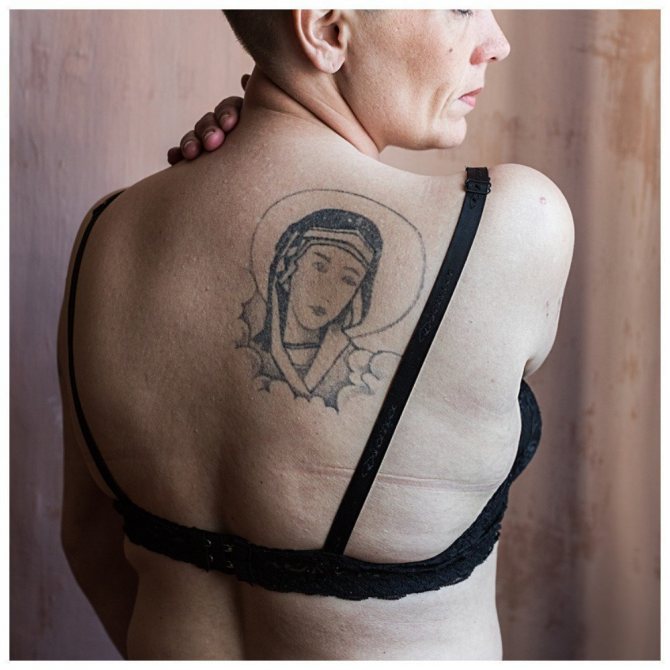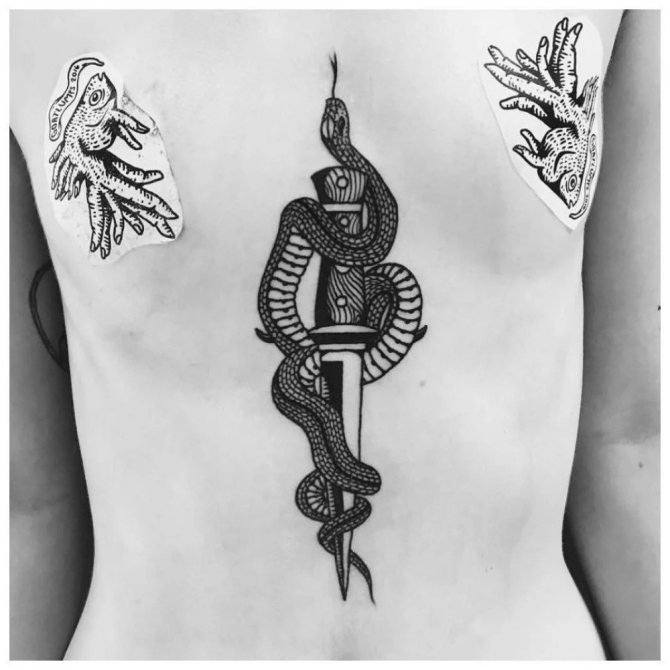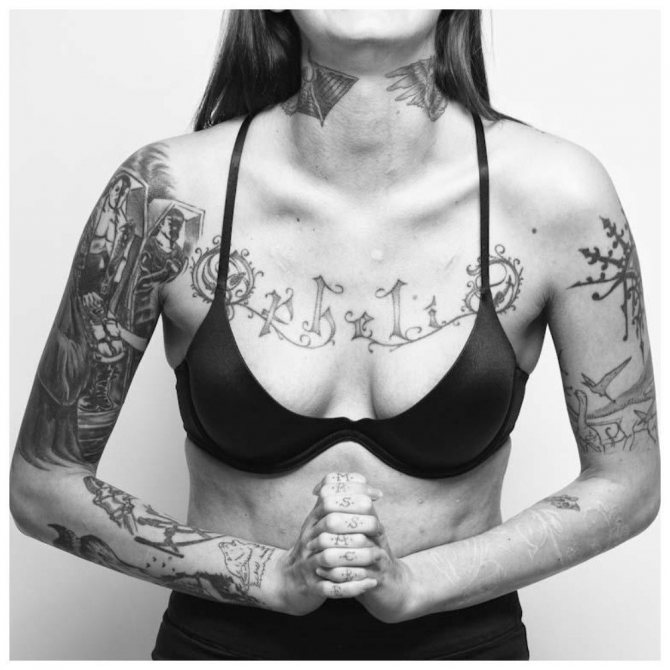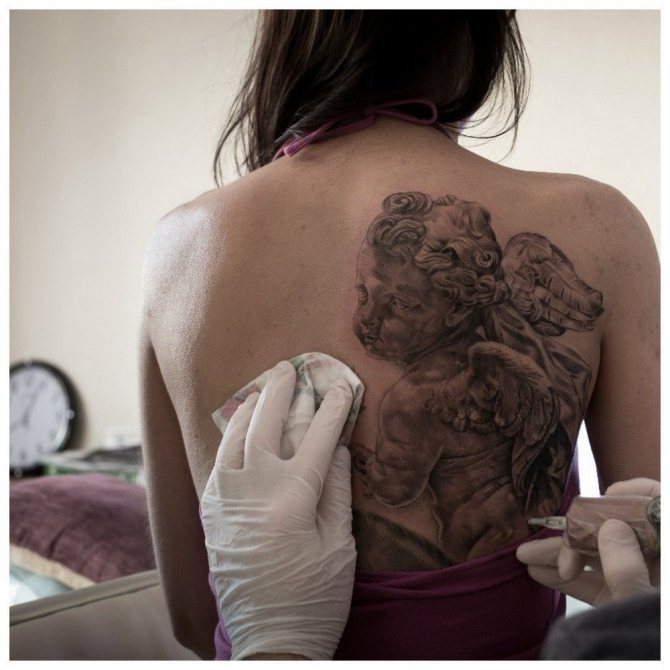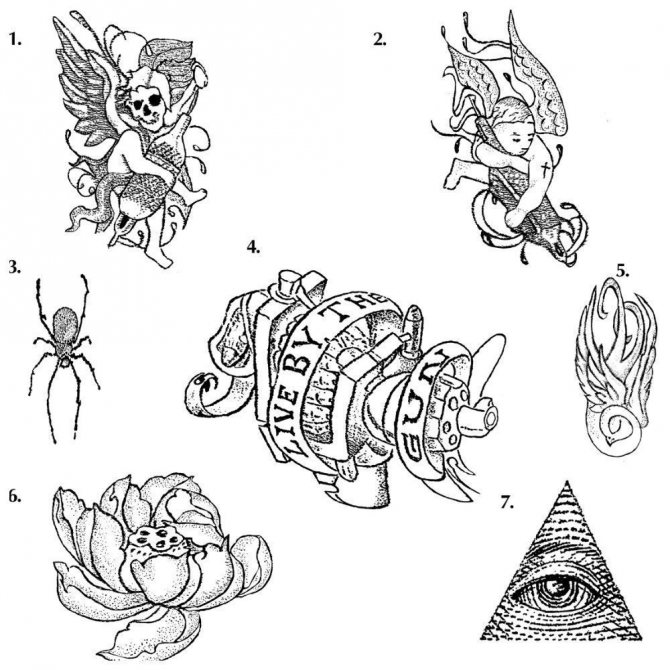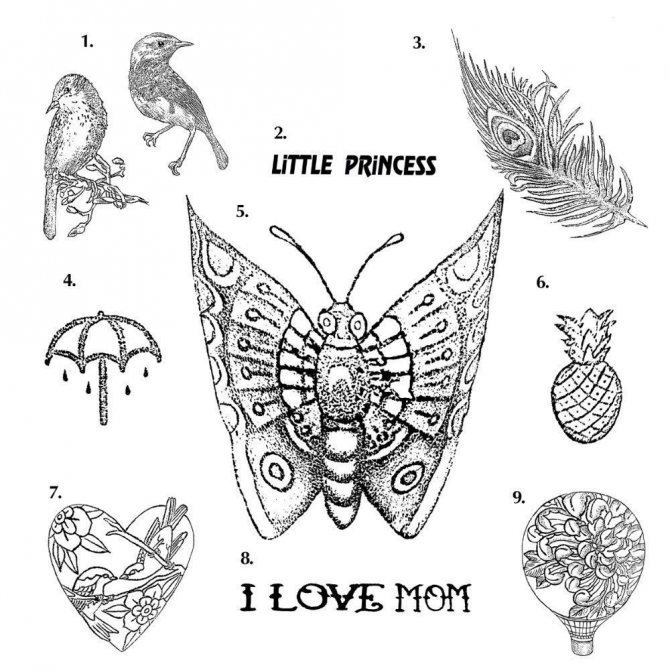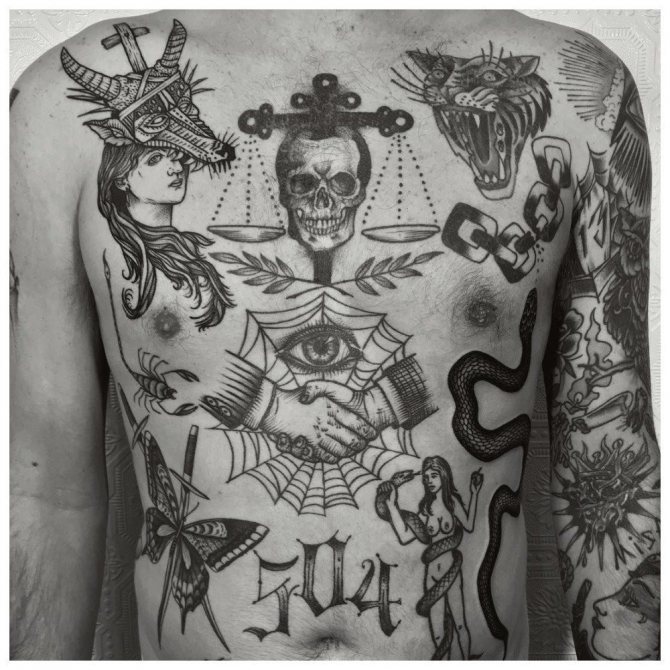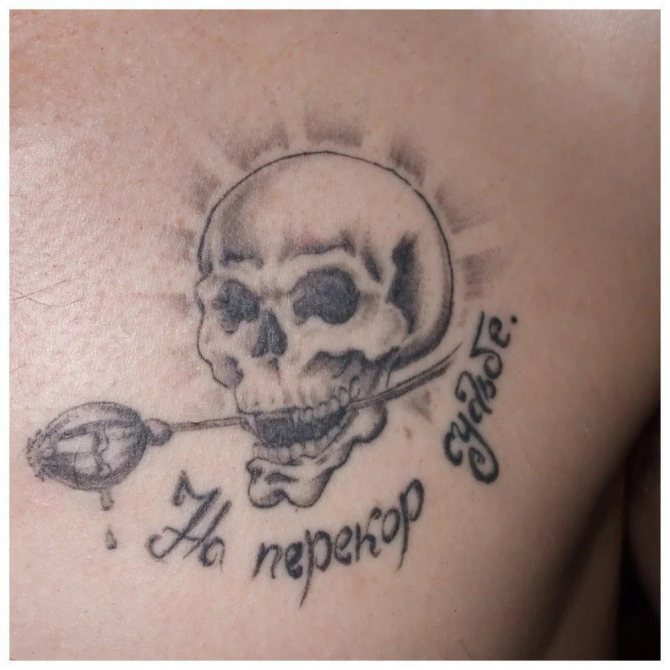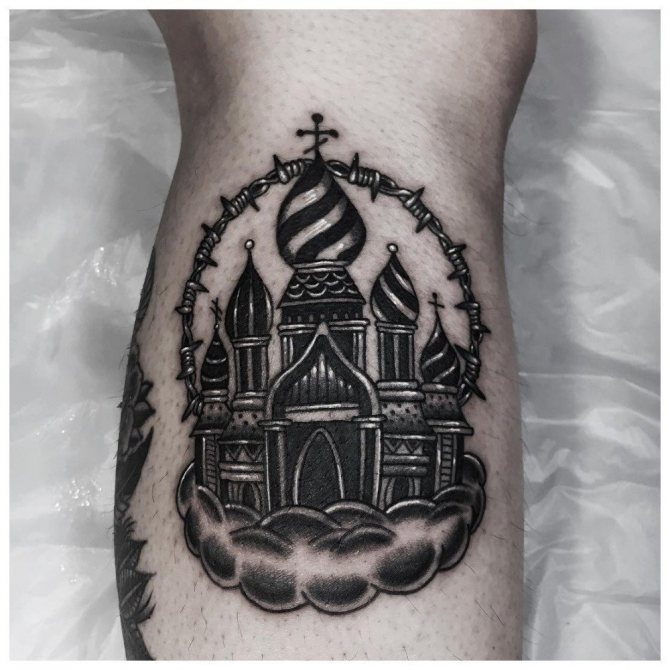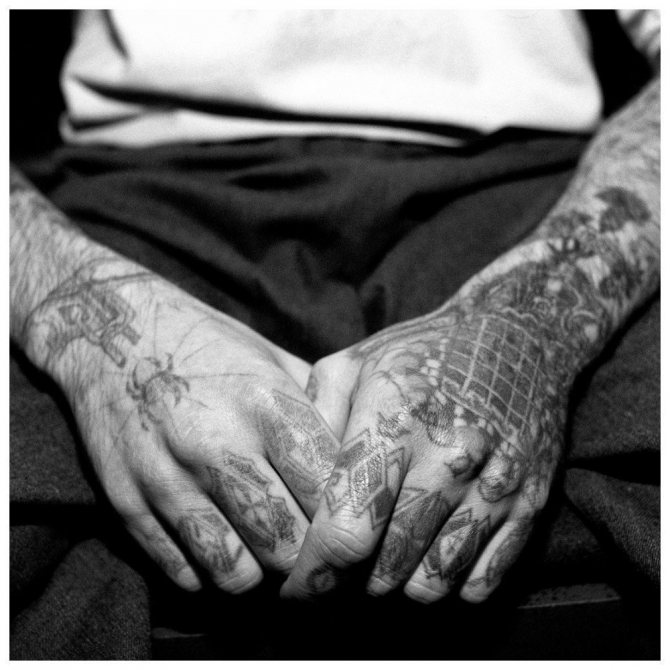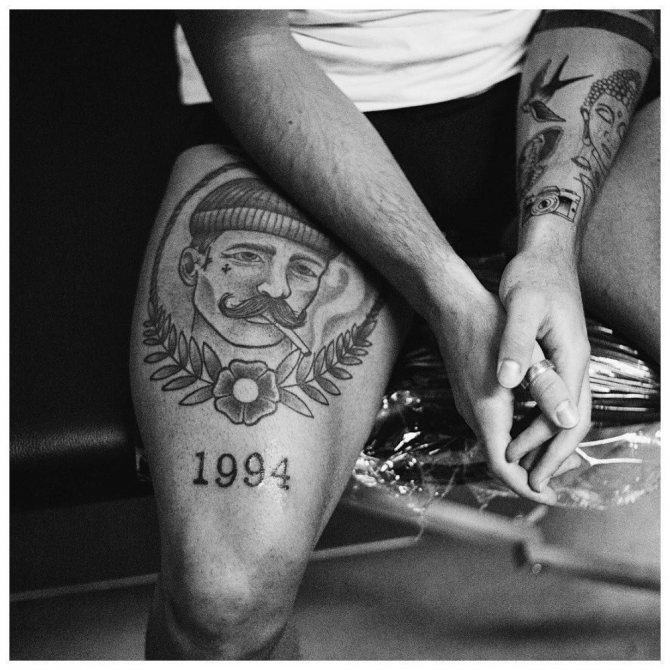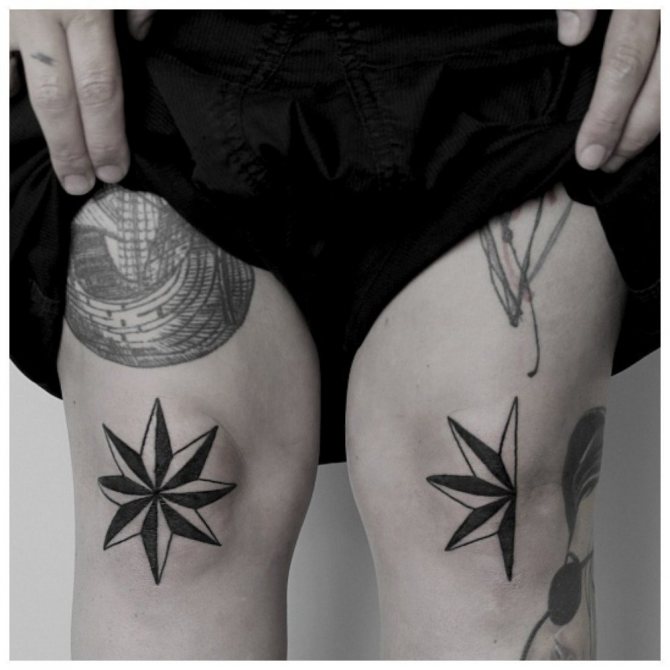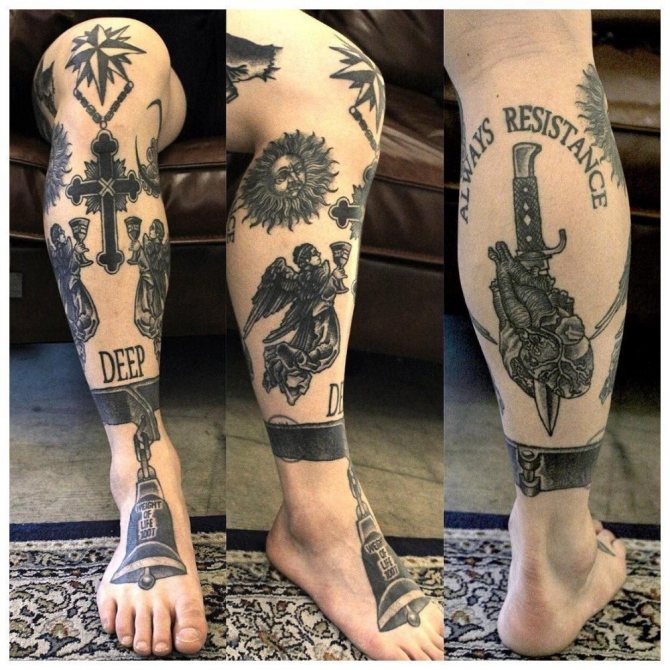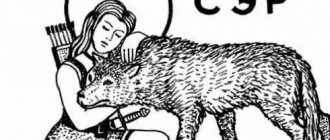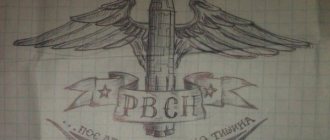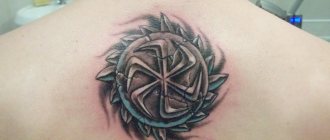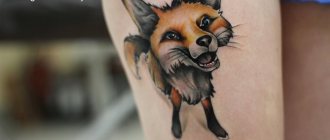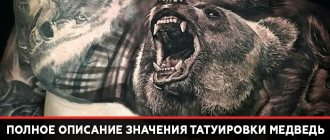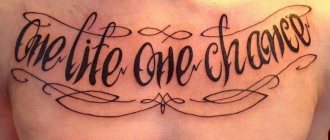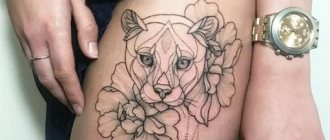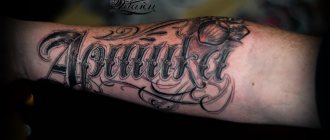Drawings and designation of thieves tattoos
Beetle in the form of a picture or as an abbreviation is often applied by thieves. The abbreviation stands for "I wish you luck stealing". - A kind of talisman for dishonest people.
As for the image, the beetle has always been considered a good talisman. amulet from various problems for its owner. The Egyptians were sure that such a picture would allow a person to carry out their far-reaching plans.
This symbol was drawn on a graffiti marker that was placed on the place where the thieves would place the beetle. It can be placed anywhere.
The most often such a tattoo is a sign that its owner is a pickpocket thief.

The bug tattoo is applied by thieves
A tattoo in the shape of a of a crosslocated on a woman between her breastsA tattoo in the shape of a cross between a woman's breasts is a mark of distinction for a thief. However, such an image can also be applied On the temple or on the finger.
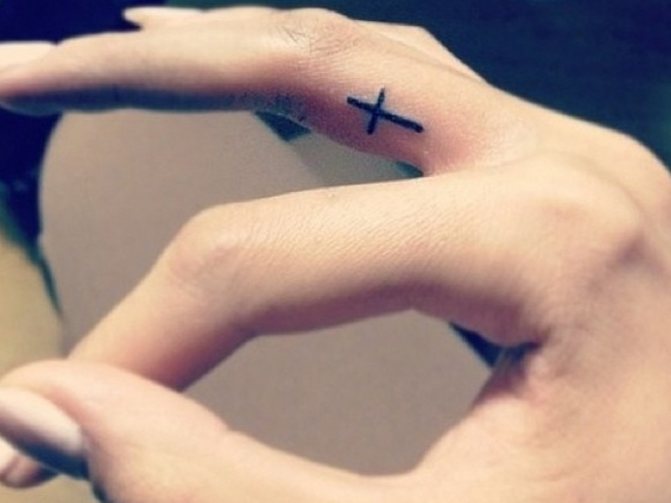

Cross-tattoo on the finger - the hallmark of thieves
Famous domes Basically deciphered as. "Prison is home to the thief." Often, however, this image means that the offender repenting for what he has done and wants to take the path of correction.
It's worth taking a closer look at at the number of domes. - They represent the number of journeys or the number of years spent in prison. At the same time the darkness is a signal of being in solitary confinement for some kind of misdemeanor. Even the number of windows in the church the number of windows in the church..
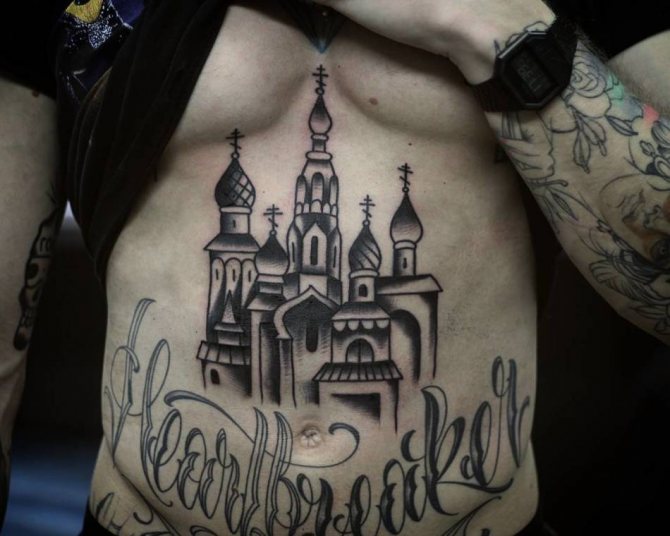

A tattoo of a dome is a thief's image that indicates remorse or informs of a time limit.
Lap stars people who consider themselves to be thieves, like to put them on their knees. authority figures. By means of the image the person says: "I will never submit to the authorities, I will not kneel before them".
IMPORTANT: Such a tattoo must be earned through various tests. If a person fails to confirm his status, he will be forced to get rid of the insignia.
To the stars are sometimes added additional details:
- Cross - "Steal and let others steal."
- Swastika - "I was born free."
- Woman with a baby - "Stealing since childhood," "I chose my own destiny."
The stars on the shoulders - are a common symbol of thieves in the law.
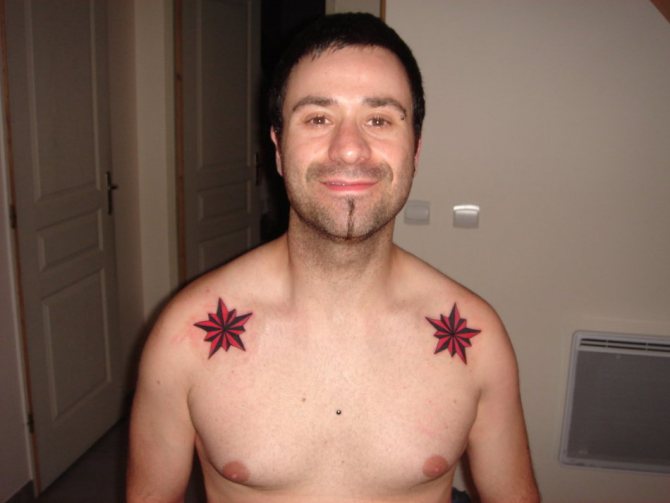

Star tattoos on shoulders are a sign of a thief in law
Spider - is not uncommon... pickpockets. In this case, the insect is placed between the index finger and thumb.
IMPORTANT: A spider web does not need to be depicted - it is mainly drawn by drug addicts.
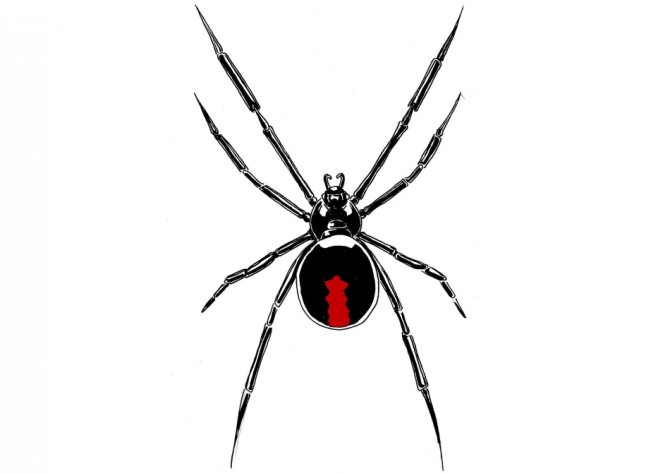

A spider-tattoo may look like this
Maps - Another sign that the owner of the tattoo belongs to the world of thieves. It was not uncommon for the cards to be an allegory of sin.. Most likely, a person with such a tattoo was stealing by cheating.
The suit of spades is the sign of the thief in law, and clubs - A thief who enjoys great prestige.
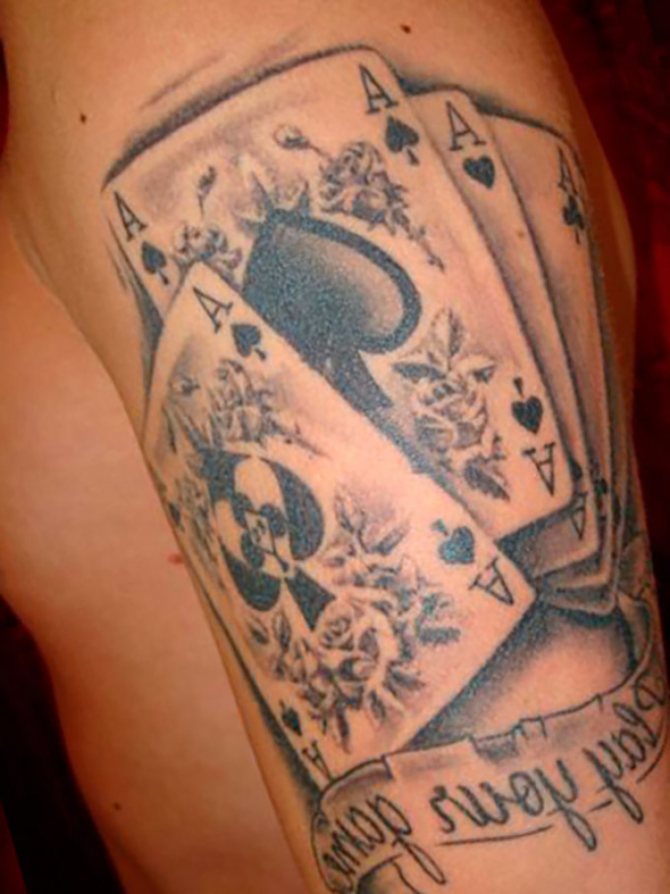

Playing cards are shown predominantly in the suit of spades
Bat - is associated with theft of property at night. The ancient Greeks and Romans believed that this creature sees perfectly well in the dark, hence the association with of discernment and vigilance.. In any case, the beast is very good at navigating in space. - Such an ability is necessary for thieves.
IMPORTANT: However, the bat is often perceived as a messenger of death, which is not good as a talisman.
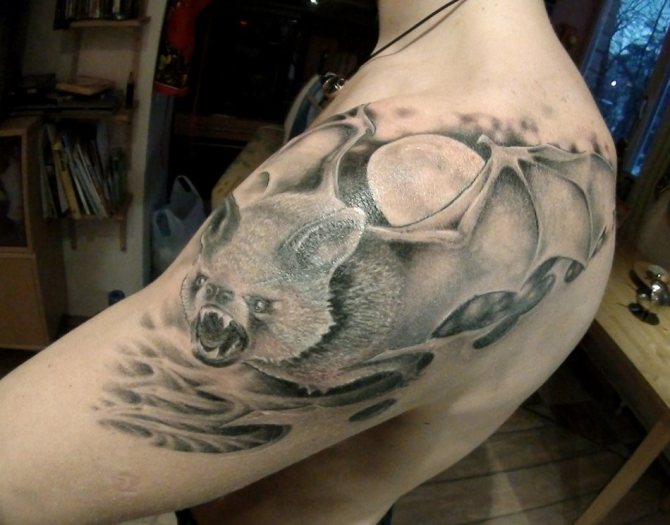

The bat-tattoo is associated with nocturnal thievery
Cat - as an acronym stands for "Native Prisoner.". As for the picture, it's applied to to home burglars.which is not surprising if you remember that the cat is tied to the house. Another interpretation is that the criminal feels at home in other people's apartments..
It's not uncommon for a cat in a thief's tattoo to be depicted with a bow and a hat. Originally, the bow was drawn to the so-called "stooges" - people who cooperated with law enforcement agencies. However, over time, this meaning lost its relevance, and the bow simply became the attribute of thieves' tattoos.
It was considered that the most prestigious to have a cat tattooed on the forearm or shoulder - This honor was bestowed upon the authorities. Ordinary burglars were satisfied with a picture on the stomach. But the leg was favored by frequent prisoners, mostly specializing in robbery. The least common picture you'll ever see on the back.
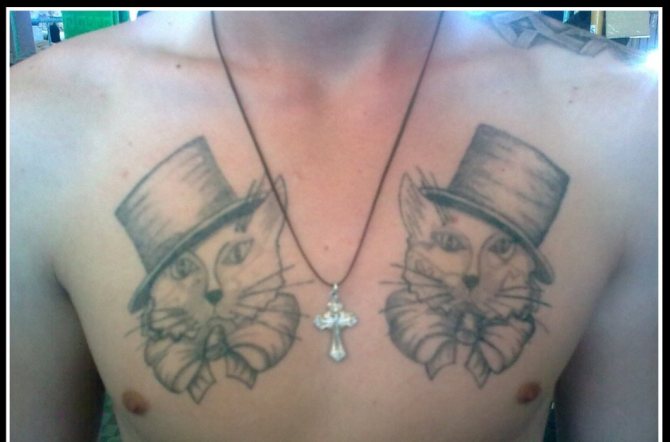

A cat tattoo for a thief should have a bow and a hat
♪ A woman with wings ♪ - ♪ was considered ♪ an amulet. This tattoo was believed to attract incredible luck. Fortune in such a case should patronize robbers.
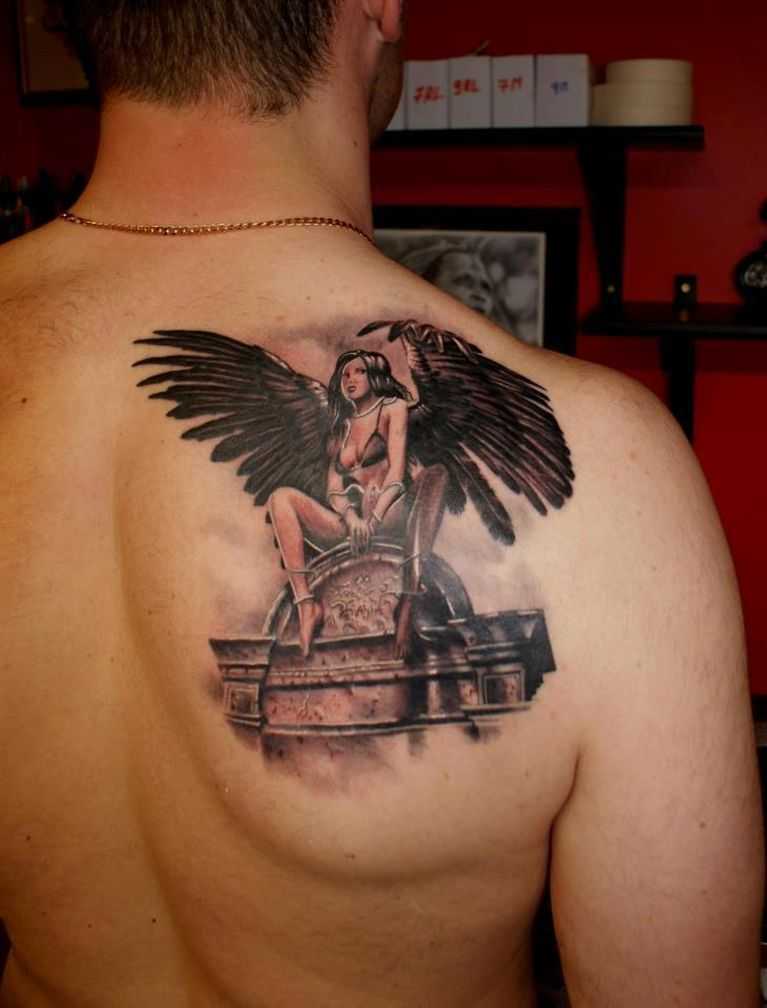

A woman with wings was applied as a tattoo as a talisman
Sailboat - sign of a burglar thief. A gastroller was a person who went about stealing in foreign cities in order to confuse their tracks. A sailboat has always been associated with wanderers, vagabonds. And the sails should preferably be white.. Most often applied on the thigh or chest, but this is optional.
IMPORTANT: It is worth paying attention to the number of masts - it is possible that on it you can find out how many convictions the owner of the tattoo had.
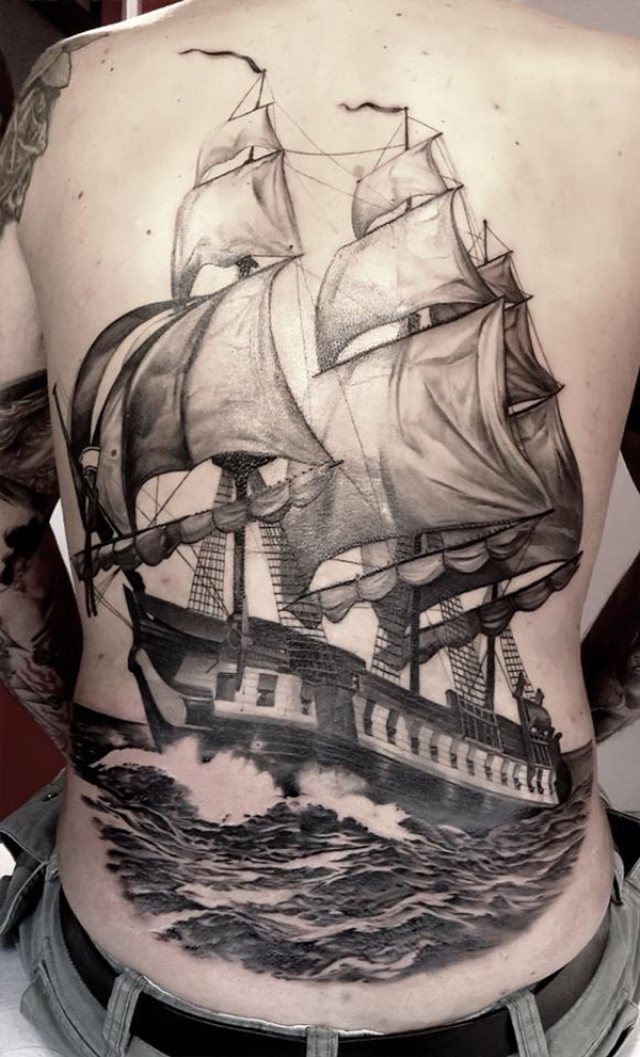

Sailboat tattoo was applied by thieves-tattoos
Book: Encyclopedia of Tattoos
Ethnic Style
"Ethnos" means "people" in Greek. And that is why in any creative work the concept of ethnic motifs is closely connected to the elements of folk art - epic or folklore, ornaments or folk crafts. That is why in the tattoo in ethnic style the wealth of graphic culture of this or that country is taken as a basis. The entire national identity of a certain nation is expressed in such a tattoo. There can be national ornaments and patterns as well as national symbols of a particular country. Such tattoos are also subdivided into several types: Polynesian, Japanese, Slavic, Celtic, New Guinean and others. They sometimes harmoniously combine ethnic and modern motifs. If this happens, we are facing a new synthetic style in the art of tattooing.
Not so long ago the Polynesian tattoo became popular. In their works masters of the early 20th century actively used elements of Polynesian national patterns, combining them sometimes with conventional designs.
What is the characteristic feature of such a tattoo? It looks like a wood carving - so bizarre and original is its pattern. The components of the pattern are varied - waves, spirals, ribbons and lines. They can converge and diverge, can be straight and broken. This style of pattern is characterized by symmetrical lines.
Among Polynesians, it was mostly men who tattooed themselves in order to emphasize their importance in society and their status. They could cover their wrists and breasts, tongue and intimate areas with the patterns.
It was not easy for a European to get a Polynesian tattoo pattern. But such patterns have long attracted attention and generated special interest in Europe.
Sometimes there were cases when Polynesian tribal leaders, out of a desire to earn extra money, sold to Europeans the tattooed heads of their executed tribesmen or enemies.
The Japanese tattoo had a special significance in the art of tattooing. Japanese style tattoos have semantic completeness and compositional clarity. This is both a means of decorating the body and a way to emphasize your individuality.
By their nature and motifs Japanese tattoos are very diverse. The patterns you can see here are very diverse: quirky plant ornaments, animals, characters and whole scenes from Japanese fairy tales and folklore. A special place is allotted to plant patterns. Everyone is aware of the Japanese love for flowers. Therefore, in the ornaments of tattoos you can find and chrysanthemums, and cherry trees, and peonies, and maple leaves - they are considered to be peculiar symbols of Japan, and therefore the use of such patterns is quite common. But it is not only plants that the Japanese use as a subject for their body jewelry. Very often images of animals, both real and fairy-tale, are pecked on the body. These can be images of a tiger or dragon, or a carp. Particularly popular are sea subjects.
It is believed that with the help of a seascape you can emphasize the beauty of your body in a favorable light. The heroes of folk epics or traditional Shinto deities are also considered to be a profitable and grateful subject for body images. The Japanese also use a portrait direction in tattooing. The drawing is placed strictly at a certain angle - such a direction is called ukiyo-e.
The canons of tattooing in Japan were formed in the XIX century - and the masters are trying to strictly follow the rules established at that time. The main requirement is that elements of the pattern must be applied asymmetrically. The outline of the pattern must be outlined thinly. The edge of the pattern should be brighter than the main color.
The Japanese tattoo is characterized by a large scale. The empty areas between its components must be filled with small-sized ornaments.
Japanese masters are also famous for an innovation - they invented movable body art. How is the effect of movement achieved? They are placed in the areas, the projections of the muscles. What is the most frequent subject of such pictures? Certainly, Samurai duels or battles of Sumo wrestlers.
Nowadays the Slavic style is also very popular. From numerous archeological findings, it became known that the Slavs also did not neglect the body jewelry. In ancient times the representatives of the Slavic tribes used the symbols of fertility in tattoos. Applied body designs in the form of rhombuses, crosses, dots, commas and spirals.
The tattoo culture was widespread in Serbia, Yugoslavia and Herzegovina. In the eleventh century new elements were introduced into the already established culture of body decoration - symbols of the Catholic Church.
Among the Slavs there were both female and male tattoos. What did the Slavs like to depict? Women often had garlands and crosses, sprigs of plants and flowers. Men covered their bodies with images of crowns and hearts or inscriptions with their own initials - so they tried to emphasize their noble origin. In the modern Slavic tattoo style organically combined Slavic and Scythian motifs. Sometimes used symbolism of Christianity and elements of Slavic script. Often masters use images of traditional Slavic folklore - fairy tales, bylinas or songs. Often the basis are taken paintings by famous Russian artists - Vasnetsov, Vrubel or Vasiliev. Sometimes in such tattoos there are elements of folk art - the motifs of Khokhloma, Gzhel or Palekh.
What is the meaning of Scythian motifs in Slavic tattoos? Scythians were the ancient tribes that roamed the territory of modern Russia. In the Scythian culture were very common images of animals: deer, horses, leopards and others. That is why the Scythian style is often called the Animal Style. The use of such motifs in the Scythian culture is not accidental - these peoples were nomadic and were constantly fighting over the best pastures or the best foraging routes. Therefore the cult of strength and valor was in the first place here.
To feel victorious - that is what the ancient Scythians wanted. Animal motifs are routinely found in the items discovered by archaeologists from the Scythian kurgans - horse harness, weapons and household items. And so far one is amazed by the richness of motifs and shapes of Scythian ornamentation.
The richness of techniques and forms as well as motifs are the main features of the Scythian style in tattooing. The main emphasis here is on the quality of the image depicted. What are the other main characteristics of this style? First, the use of limited space. Secondly, a sufficiently large number of additional elements are used. And, thirdly, small drawings are placed inside the large ones.
The image in the Scythian style is quite recognizable. It consists of waves and cross-shaped figures and swastikas. Often there are also various ornaments of buds, flowers or leaves placed inside a geometric figure.
Scythian style artists often used figures of animals - their images are symbolic in nature. These could be deer or horses, wolves or tigers, moose or leopards. Sometimes there were also bird images - geese, griffins or eagles. A griffin with horns and a crest was a recurrent motif of the Scythian ornament.
Unusually popular Celtic tattoos. They combine many cultural traditions of different nationalities. Slavic and Byzantine styles had a very strong influence here. The Celts widely used in their style plant patterns - flowers and leaves, as well as twigs. Due to the interaction of ancient cultures elements from other countries - Slavic, Gothic and Indo-Aryan - penetrated into Celtic culture. So it is more likely that we are not talking about the Celtic style, but the Celto-Romanic one.
The New Guinean tattoos consist entirely of geometric figures. With the help of such patterns are composed of a whole ornament. The patterns were applied in the following way: first the incisions were made on the skin, and then their places were filled in with a dye composition.
One of the most spectacular styles of tattooing is considered black & grey. In this style is widely used basic tones and halftones. Such images are characterized by volume and scale. Portrait images and abstract drawings are made with the help of this style.
The concept of cyberstyle came into use with the light hand of science-fiction artist Hans Ruedy. He was the first to create on canvas an image-hybrid of a machine and a living organism. What does the cyber-style tattoo depict? Alien beings, cyborgs, extraterrestrial animals - in short, everything that is associated in our view with extraterrestrial civilizations. Such masters can also create the illusion of a mechanical arm or leg.
Allocate, in addition, tattoos in the modern Russian style. They widely use the achievements of old masters in combination with new methods. Here the most different patterns are used: spirals, dots, crosses, etc. They also depict ornaments taken from books or folk crafts. Various plots from fables and folktales remain popular.
Women's prison tattoos
Female prison tattoos have far fewer meanings than male prison tattoos, but in many ways they are similar. For example, women also get tattoos on their fingers to indicate their membership in the thieving caste.
If a woman in the zone gets a tattoo in the form of a rose, butterflies on her shoulder or a female silhouette with a crown, it means she has low social responsibility. The source of such tattoos is the branding of a lily on the shoulder, which was burned in medieval France to girls engaged in prostitution.
Share it with your friends!
Subscribe to our channel Yandex.Zen or Yandex.Messenger
Tattoo on hands and knees
The main tattoos on the hands are located directly on the fingers. Tattoos on the phalanges of the fingers are a calling card of the prisoner. In addition to this often cover the outer part of the palm and forearm nakolkovki.
The main theme of such drawings is religion. Therefore, most often depict the faces of Saints, as an indicator of one's affiliation with a particular religion; crosses, as a symbol of criminal authority; the Star of David, the crucifixion of Jesus, etc.
A tattoo on one's knees is a symbol that a person is not ready to bend and literally kneel before someone. For example, if a criminal has stars depicted on his knees, it means he loves freedom and refuses to obey the laws.
Criminal tattoos
Criminal tattoos are usually drawn on in places of detention. For prisoners and ex-prisoners, criminal tattoos have an important role and special meaning that not everyone understands. The tattoo on the body of the prisoner can tell a lot about the owner: from the number of trips to the character and status in the criminal world. These days, the concepts of these or those tattoos have changed somewhat, and not knowing all the subtleties of criminal designs, you can accidentally make yourself a prison tattoo.


In the first decades of Soviet rule, the caste division of the criminal community was very strict. The owner could be punished severely, up to and including death, for having an "off-duty" drawing tattooed on him or her.
Gradually, morals, like in the rest of society, softened, and the final "liberalization" occurred with the end of the Soviet system and its cultural taboos. The first legal tattoo salons were opened, and the wide masses stretched for a until recently half-forbidden decoration. All sorts of drawings were made, including ones that had prison implications. Later, some of the newly minted "beautiful pictures" owners ended up in jail. There they were confused by information that the design was inappropriate and the tattoo was considered criminal. This could have ended tragically.
However, even the severity of thieves' mores proved powerless against the social trend. Gradually, there became so many holders of "self-appointed" criminal tattoos in the zone that the fight against them lost all meaning. The sanctions against such "violators" ceased to be applied, and this rule is still in force today.

